MiGs, Stars & Magic Books: A Brief History of Trespassing in Moscow
An illustrated guide to urban exploration in the Russian capital.

20 October 2013
Stretching to an estimated total length of 2,500km, the Odessa Catacombs are perhaps the largest network of tunnels anywhere in the world. They’re significantly longer – and more complex – than the famous catacombs found beneath Rome (300km) and Paris (500km)… in fact, if these Ukrainian tunnels were stretched out to full length, they’d reach further than the distance between Odessa and Paris.
I decided to shun the official tour of the catacombs, which is strictly limited to a kilometre-or-so of safe, well-lit tunnels. Instead I found myself an unofficial guide, and made arrangements to be led on an extended trek into one of the deepest, darkest places on earth.
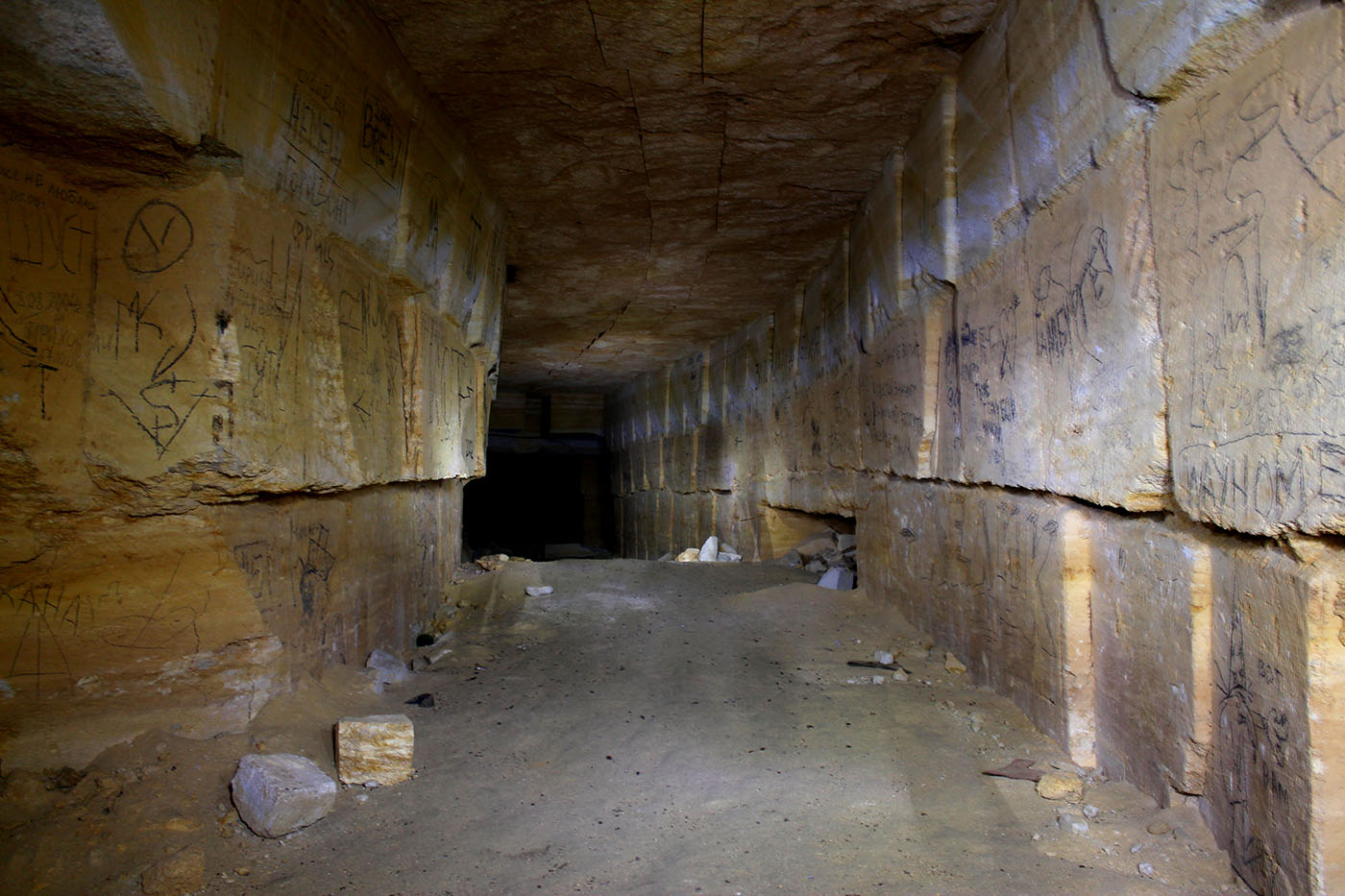
I arrived at Odessa by train; crossing into Ukraine after my week in the unrecognised socialist republic of Transnistria.
I knew I wouldn’t have long in Odessa, as I was preparing to travel the length of Ukraine in search of its darker, more infamous attractions – from Object 221 and the Balaklava submarine base in the Crimea, all the way up to Chernobyl and the abandoned city of Pripyat in the far north.

Before any of that though, I was dying for a chance to look at the Odessa Catacombs.
The oldest tunnels here are believed to date back as early as the 17th century, if not before. Created as an extension to natural cavities beneath the ground, the first man-made passages were used by smugglers, as well as being a source for construction materials. The city of Odessa grew rapidly throughout the 19th century, and the catacombs were widened and extended as they became a key source for the limestone used in so much of the city’s iconic architecture.
Odessa’s intensive multilevel mining operation accelerated during the second half of the 19th century. Limestone was cut using saws, before being carted along narrow passages by oxen and mules. Many of these creatures were said to be almost (if not completely) blind, often living their whole lives in darkness.
By this time the mines spread across three distinct levels, at their lowest points reaching a depth of 60m below sea level.
Following the Russian Revolution of 1917 the operation was suspended… and the abandoned mines were reclaimed by the criminal classes. They remained the province of outlaws and vagabonds up until WWII: when the Nazis arrived in Odessa, and Soviet troops were forced to retreat towards Moscow.
Unbeknownst to German and Romanian invaders however, the Soviets left key strategic units positioned beneath the city. These Ukrainian partisan groups hid deep within the catacombs, from where they continued to launch surprise attacks on the fascist forces.
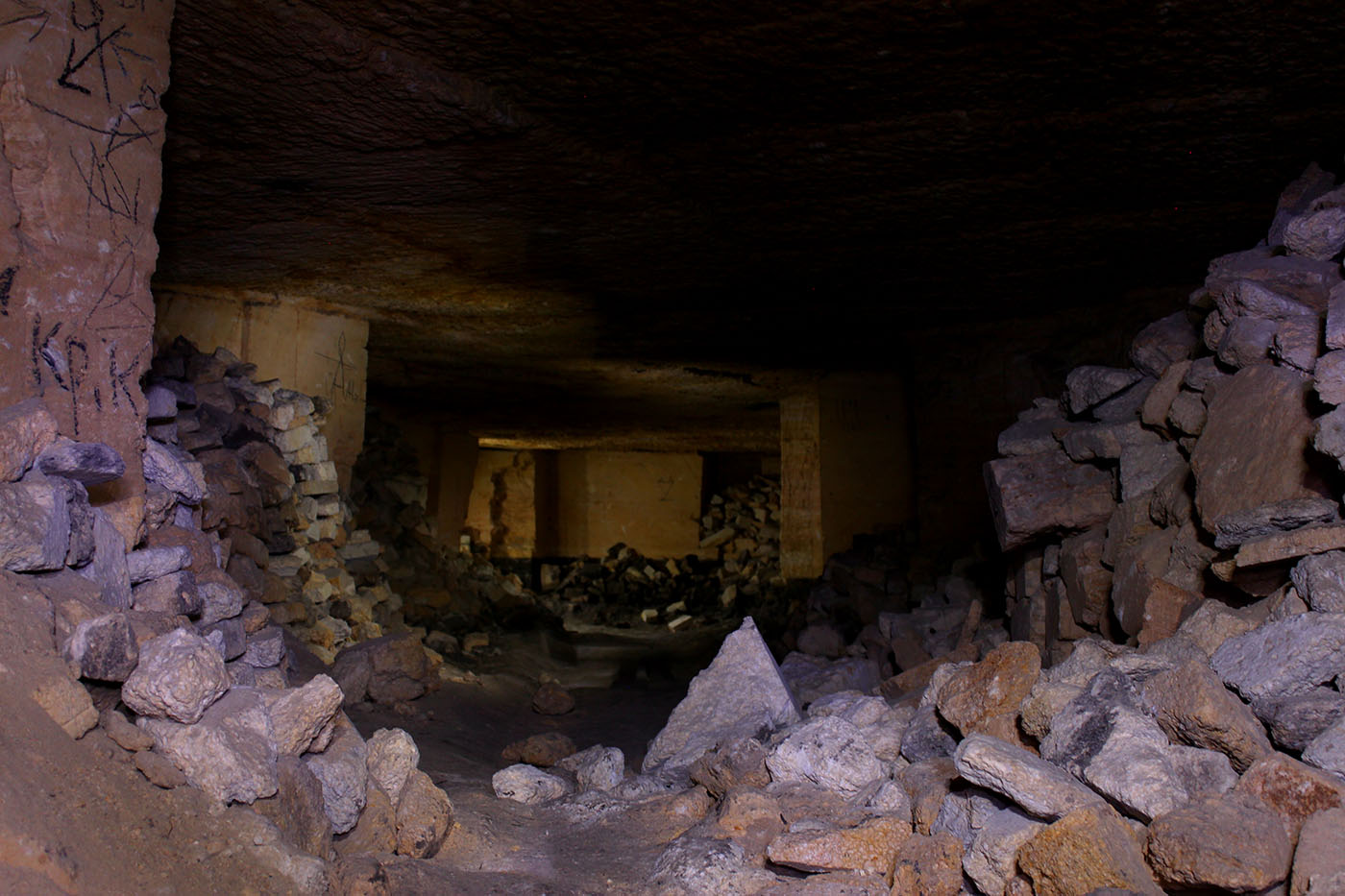
Much of the modern-day interest in the Odessa Catacombs is related to the daring exploits of the city’s Soviet partisans… there are even official tours that one can sign up to. Many tourists visit the ‘Museum of Partisan Glory’ at nearby Nerubayskoye, where there’s a kilometre-long section of catacomb neatly arranged with period-costume dummies and rusty WWII weapons. According to reports the guided tour takes a couple of hours, with either end of the museum section sealed off to prevent tourists gaining access to the endless, twisting network of tunnels beyond.

However, the museum segment represents just 0.04% of the total catacomb network – and I was intent on seeing the real deal.
Back in Tiraspol, hours of trawling through blogs and forums – most of them written in Russian – had rewarded me with the name and email address for an unofficial tour guide. As we negotiated the terms of the expedition, I explained to Egor that I wasn’t interested in his usual tours: where small groups of tourists are taken into the catacombs through a hidden entrance, to spend two to three hours walking safe and familiar paths.
I wanted to get a real sense of the length and depth of these catacombs – this wasn’t my first underground expedition, and the Odessa Catacombs are no ordinary tunnels. I wanted to understand what it meant to feel lost, hungry and afraid, crawling through the sandy darkness in some deep corner of the world’s largest network of underground passages.
“Ok,” replied Egor. His simple response did little to prepare me for what I was getting myself into.
Just one hour after arriving in Odessa I had met up with Egor, and he led me through the wide cobbled streets of Odessa; through crowded markets and past secluded courtyards where old men gathered to play chess, towards our bus pick-up point.

Squeezing onboard the over-filled marshrutka we met Vanya: Egor’s friend, and another committed cataphile. The bus journey took us around half an hour, heading north out of the city towards the village of Nerubayskoye. It was here that our expedition would begin, not far from the entrance to the Museum of Partisan Glory.
We stopped off at the village shop, stocking up on snacks: freshly baked pastries and a hefty knot of Georgian cheese strings. I wasn’t hungry, but I had a feeling I’d need the energy later on.
Minutes later, we stood beside an overgrown path on the edge of a rolling valley. This uneven terrain was not what I had been expecting, but nevertheless, before us opened the low entrance to a mineshaft – one of more than a thousand such entrances which have been documented in the region surrounding Odessa. We donned headlamps, and headed down.
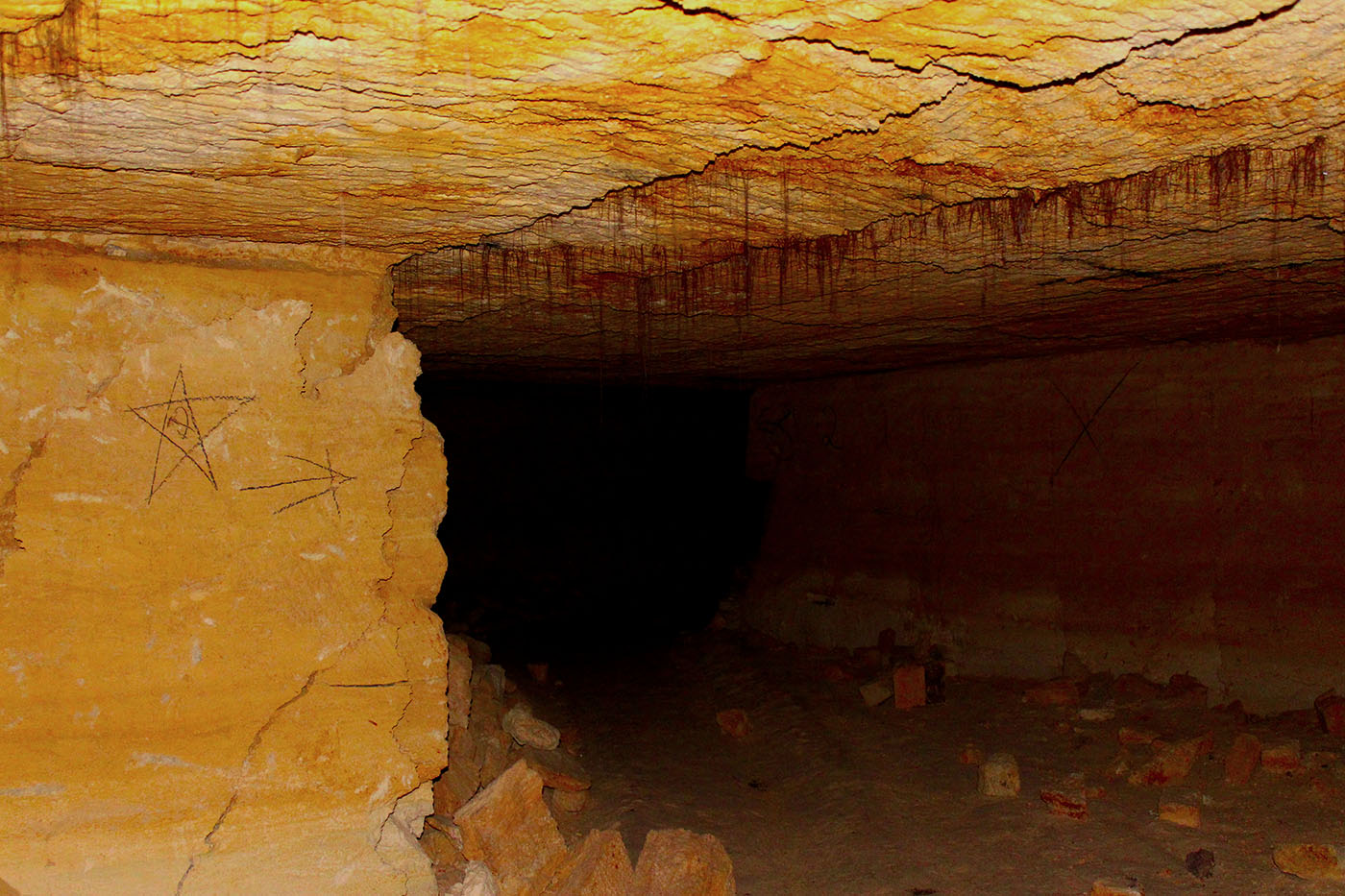
The ceiling inside was low, forcing me to duck as anaemic roots brushed my face; thin tentacles fanning out from cracks in the rock above. While the tunnels were bathed in perfect darkness, each camera flash lit up the walls in brilliant shades of orange and yellow stone.
As we walked Egor pointed out some of the scars left on these tunnels by the intensive mining operations.
Some of the larger passages were as much as 3m in height, with distinct lines on the walls which showed were first one level and then another of limestone had been harvested from the ceiling.
Some of the sharper corners bore deep grooves at around chest height, formed over many years as the oxen and mules would drag their harnesses against the wall.
We passed by cryptic markings, scrawled on walls and prominent corners using chalk. Egor and Vanya were eager to teach me the code, showing me how to deduce the direction of the nearest exit from each cluster of lines and circles.
“Diggers don’t make maps,” Egor was telling me. “It’s against the rules.”

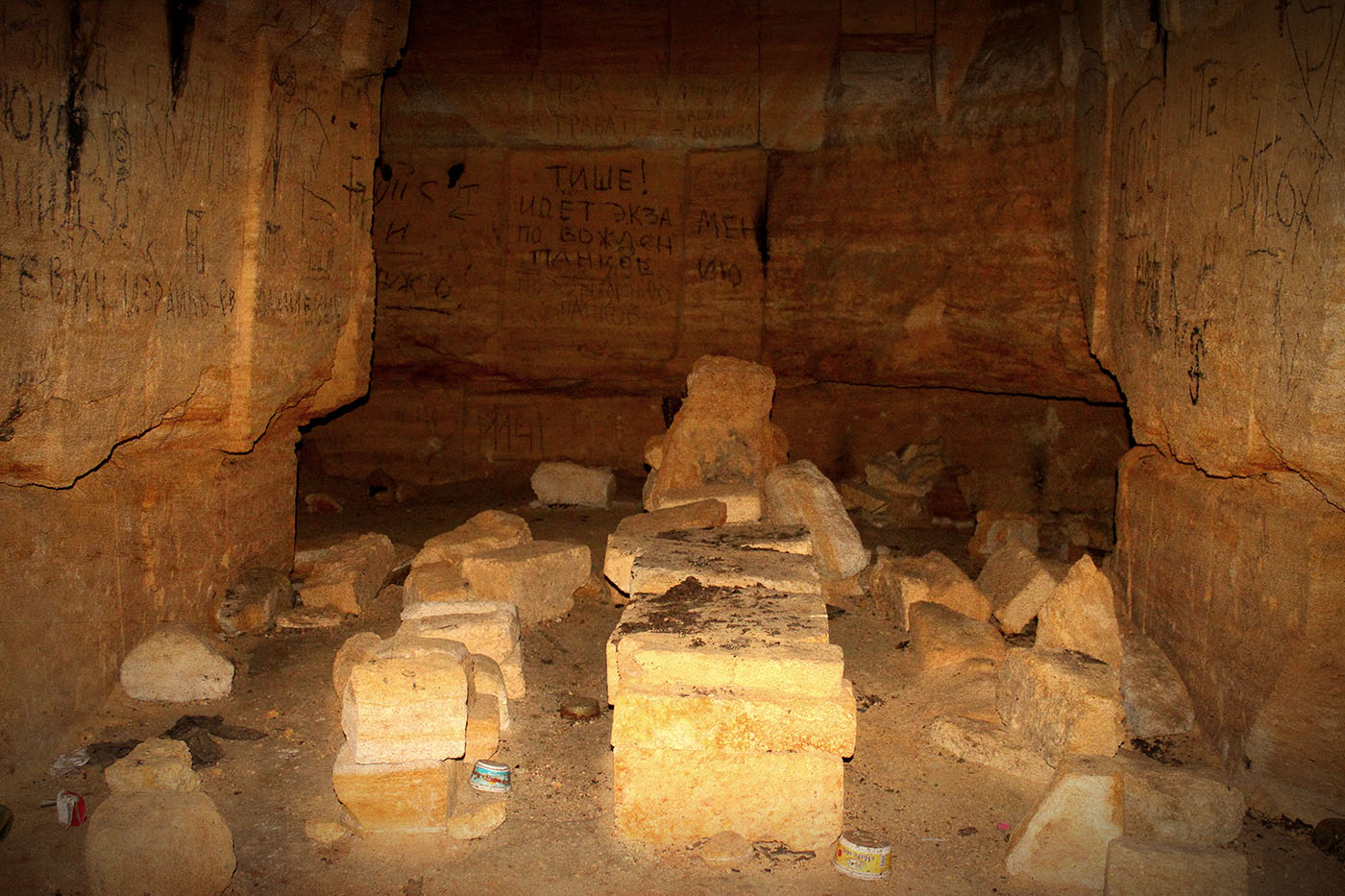
There seems to be a strong code of conduct amongst those who chart the depths of the catacombs – or ‘diggers,’ as they often refer to themselves. Mapping the tunnels is forbidden, a tradition which seems to stem from the philosophy of the partisan rebellion. What was true then, during the war against fascism, appears to hold true today: these catacombs belong to Ukraine, to Odessa and her children. Their secrets are not for sharing [1].
From time to time we would stop and rest; using spaces carved out by the countless cataphiles who had been before.
Square slabs had been dragged into place to form low tables and stools and while most of these spaces were litter free, the bountiful graffiti gave away the location of popular hangouts.
While the Odessa catacombs are apparently a popular spot for parties, such revelry is not without risks.
On the eve of 2005, a group of local teens decided to spend the New Year getting drunk in the tunnels… and by the time they left, had managed to lose count of the group. One girl, named Masha, had wandered off at some point in the night. Her body wasn’t found until 2007, when coroners estimated that she had spent three days lost in the cold, dark tunnels before finally dying of dehydration. This photograph was taken by one of the explorers who found her body, though it’s not recommended for the faint-hearted.
Other bodies are discovered in the tunnels from time to time, many of them dating back much further. Some of the older corpses are mummified by the cold, dry air, perfectly preserving the remains of partisans and smugglers. Other recent discoveries in the Odessa catacombs have included weapons caches, items such as WWII-era rifles and grenades.

Of course, such findings tend to be well removed from the more commonly-travelled routes through the catacombs. We were heading straight for those depths, though – both Egor and Vanya were keen to explore new, unfamiliar territories, and what started out as a tour was fast becoming an expedition into the unknown.
“You see this wall?” Vanya asked me, pointing towards a modern barrier blocking the passage to our right. “Behind this is the museum. Now we’re in the real catacombs.”
The deeper into the catacombs we went, the harder the going became.
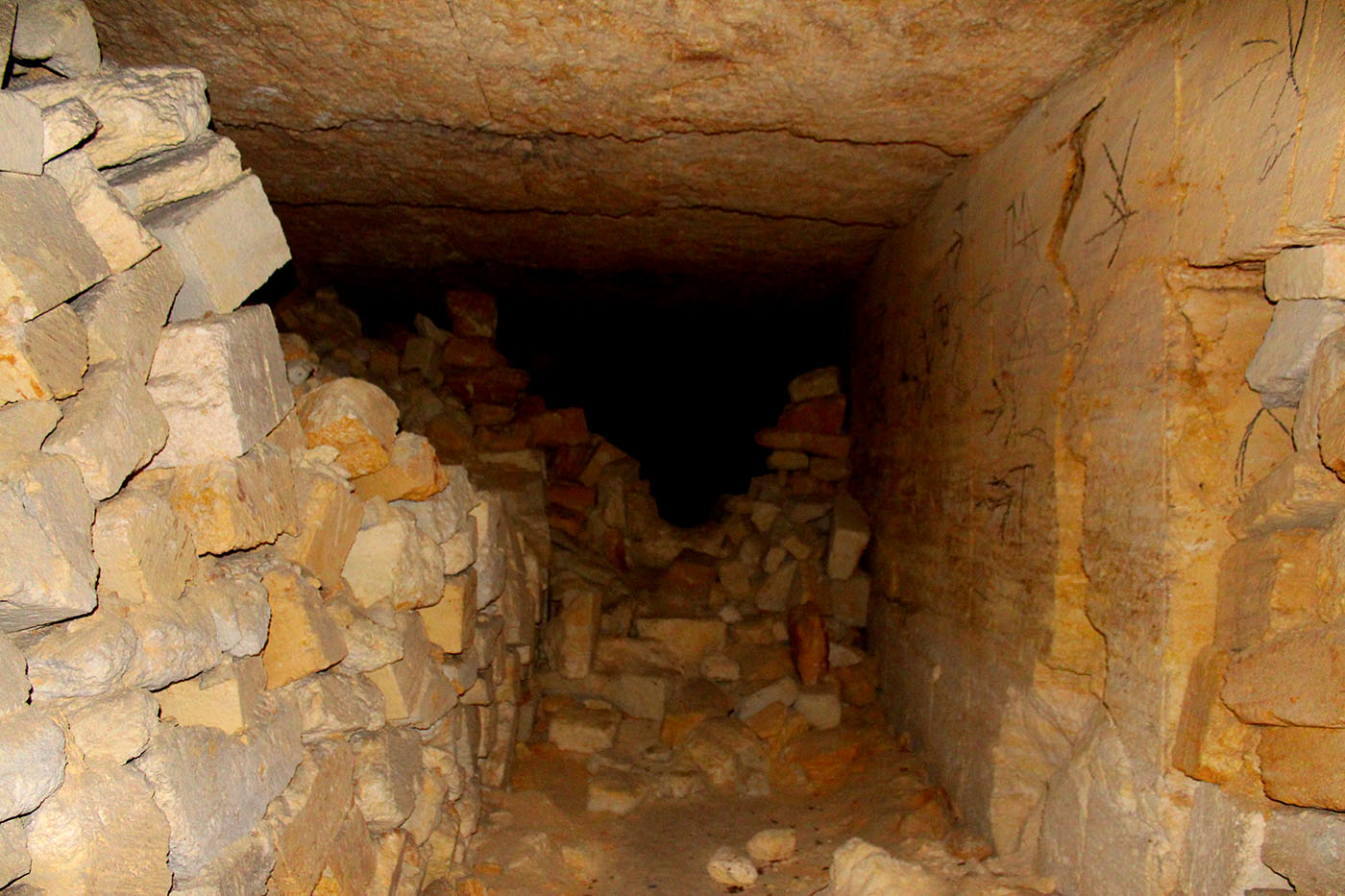
Sometimes we’d be forced to squeeze through narrow cracks in the rock, or climb the debris left in the wake of a rockfall, before finding ourselves back on track.
On a few occasions we found our path blocked altogether; where brittle layers of sandy rock had collapsed to form impenetrable walls ahead.
I was alarmed to discover that even some paths once familiar to my guides were now impassable – these cave-ins were both recent and regular. I asked about the chance of a cave-in occurring, to be told:
“Don’t worry – there’s always another way.”


The occasional litter we found gave away the timelessness of these tunnels. Faded chocolate wrappers dated back a decade, while in other places I found VHS and cassette tapes strewn on the ground. These had been smashed apart, their tape spools removed to be used as navigational aids… the story of Theseus and the minotaur, reimagined for the 1980s.
In another passage my boots hit soft, mushy ground – and, shining my torch across the tunnel I found we were walking through a tar-like black sludge.
“You don’t want to step in that,” Egor warned me. He told me that many people used the catacombs as sewers, pumping their waste out of sight and into the forgotten tunnels below. Here and there he showed me dark liquid flowing in rivulets down the walls, from fissures in the rock above.

Sometimes the locals find an entrance to the tunnels, and use it for landfill – dumping mountains of household or industrial waste into the hole. In other places plumbers have been known to bore waste pipes through the crust, pumping sewage and other dregs straight into the catacombs. It’s quicker than installing real drains, Egor told me, and saves the customer the ongoing cost of sewerage charges.
Turning the next corner my torch beam disturbed a pair of rats, busily feasting on the filth. I suspected I’d see plenty more before I breathed fresh air again.
By this point we had been underground for around three hours, and were just reaching the deeper levels of the catacombs. Our journey was broken up with stops at regular rest points, many of them bearing the signs of recent activity; candle wax, cigarette butts and graffiti scratched into the stone walls. Other graffiti seemed much older, as well it might have – these very same base camps were once the domain of Odessa’s 6000 or so Soviet partisans, who hid themselves in the catacombs for as long as 13 months after the Nazi invasion.

In 1941 Odessa was invaded, as Germany and its allies swept east across Europe. Following the siege came the massacre of well over 100,000 Ukrainian Jews, while the city of Odessa was made a part of Transnistria; and thus fell under Romanian authority.
Equipped with radios, the rebels would relay information to the Soviets; as well as launching strikes on their unsuspecting foes, springing out of secret entrances hidden right across the city – before disappearing back beneath the earth.
In response to this invisible terror, the German and Romanian armies began sealing entrances to the catacombs, hoping to entomb the Ukrainian rebels. Sometimes they would drop canisters of poison gas down shafts, in an attempt to smoke them out. Either they underestimated the rebels, however, or they had underestimated the extent of the catacombs. By the time the Red Army returned to liberate Odessa in April 1944, still some partisan forces remained in the tunnels – surviving malaria and malnourishment, and in spite of the Nazi invasion.
This deep in the catacombs, the terrain itself showed telltale signs of military occupation. Several corridors we passed had been blocked with rough stone walls, built with slots to allow for defensive fire. A little later Vanya showed me a well shaft. I looked onto the shaft from an opening around halfway up – still water below me, the night sky far above. He told me that we were currently beneath a small settlement, where villagers had secretly supported the Soviet rebels. While pretending to fetch buckets of water from the village well, they had actually been lowering down baskets of food to the partisans in whose bootprints I now stood.
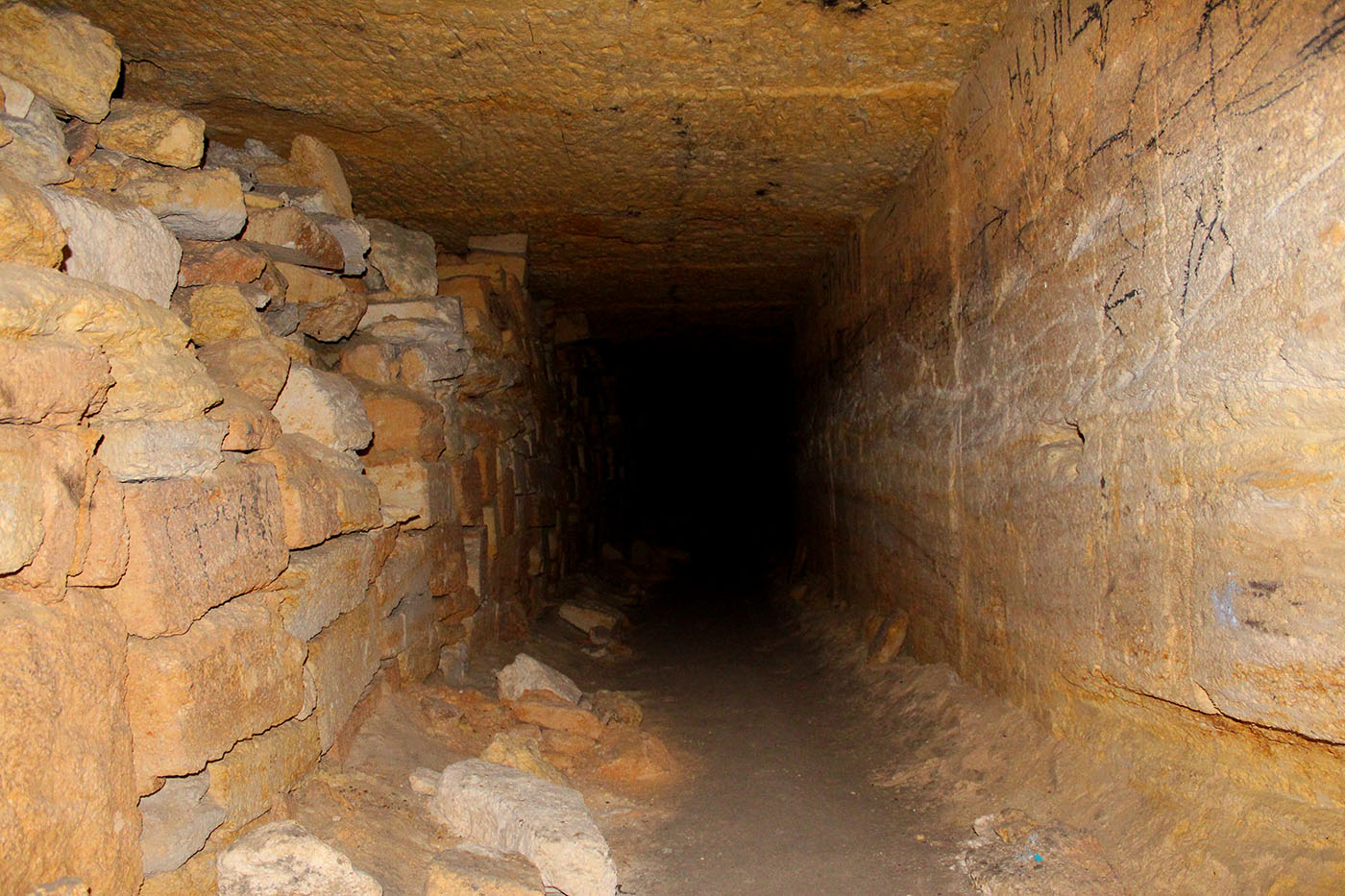

The passages in this region were far more complex than the wide, square shafts we’d been following several hours earlier. Natural rock contours surrounded us on all sides, winding from side to side, undulating over mounds and rises. We approached a wide chasm in the ground, and Egor invited me to climb down first.
I left my bag and camera with my guides, as I lowered myself into the darkness – joking, as I did, that it would be the perfect opportunity for them to kill me and take my stuff.
Vanya smiled.
“If we wanted to kill you, we’d have done it a long time ago,” he said. And it was true, of course. I had well and truly succeeded in my first mission: to get lost in the catacombs of Odessa. By now I could safely say that my life was resting in the hands of two young Ukrainians I had only known since lunchtime.
There’s no way any one person could ever witness the true scale of the Odessa Catacombs; explore all 2,500km of tunnel. The longest single expedition to date was just 40km, completed over a 27-hour period in 1995. Many regions (such as the notorious ‘K-29’ network) remain largely unexplored to this day.

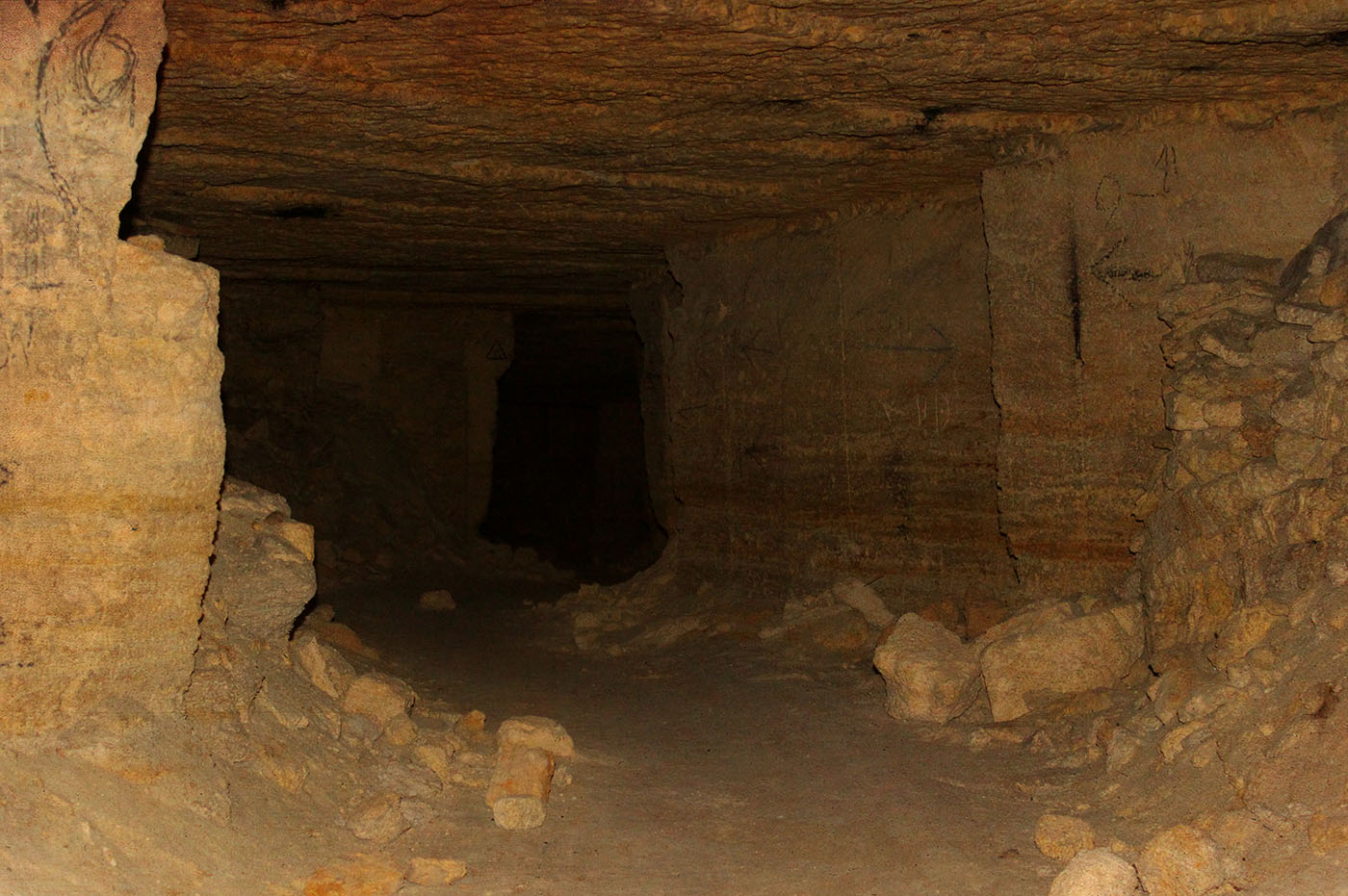
For that reason, I knew I wouldn’t be content simply following a safe path, and knowing that I was in one small corner of the world’s largest catacombs; I needed to feel it, to experience exactly what that meant.
By the time we had been walking through tunnels for six straight hours, I was beginning to reach that awareness. My feet were sore, and my neck hurt from long periods of stooping beneath low-hanging ceilings. I still had plenty of food, water and batteries for my headlamp, but these items were weighing me down more with every step. On top of that, my internal navigation system had now completely given up on me.
For the first few hours underground, I had felt as though I still had a pretty good idea which way the exit was. With every twist and turn in the path my mental compass adjusted, and I was making note of prominent landmarks along the way. Towards the end though, my brain was overloading – I would have struggled to retrace the last few minutes, let alone navigate my way back to the surface.
There were times when Egor and Vanya were both likewise out of their depth. They hadn’t known what to expect when a foreigner had contacted them for such an extreme tour. By now though, it was clear that the three of us shared a very similar appreciation for the underground; the peaceful silence, the timelessness of the catacombs. The two of them led me to some of their favourite spots – many of which took some agility to reach. We climbed crumbling rock walls to reach higher levels, tip-toed across narrow ledges that hung above deep chasms, squeezed through narrow fissures into hidden passages below. One moment they’d be gleefully leading the way… the next we’d be exploring somewhere new, scouting passages that neither Egor nor Vanya had seen before.

As we made our way through the darkness, my guides told me some of the stories associated with the catacombs.
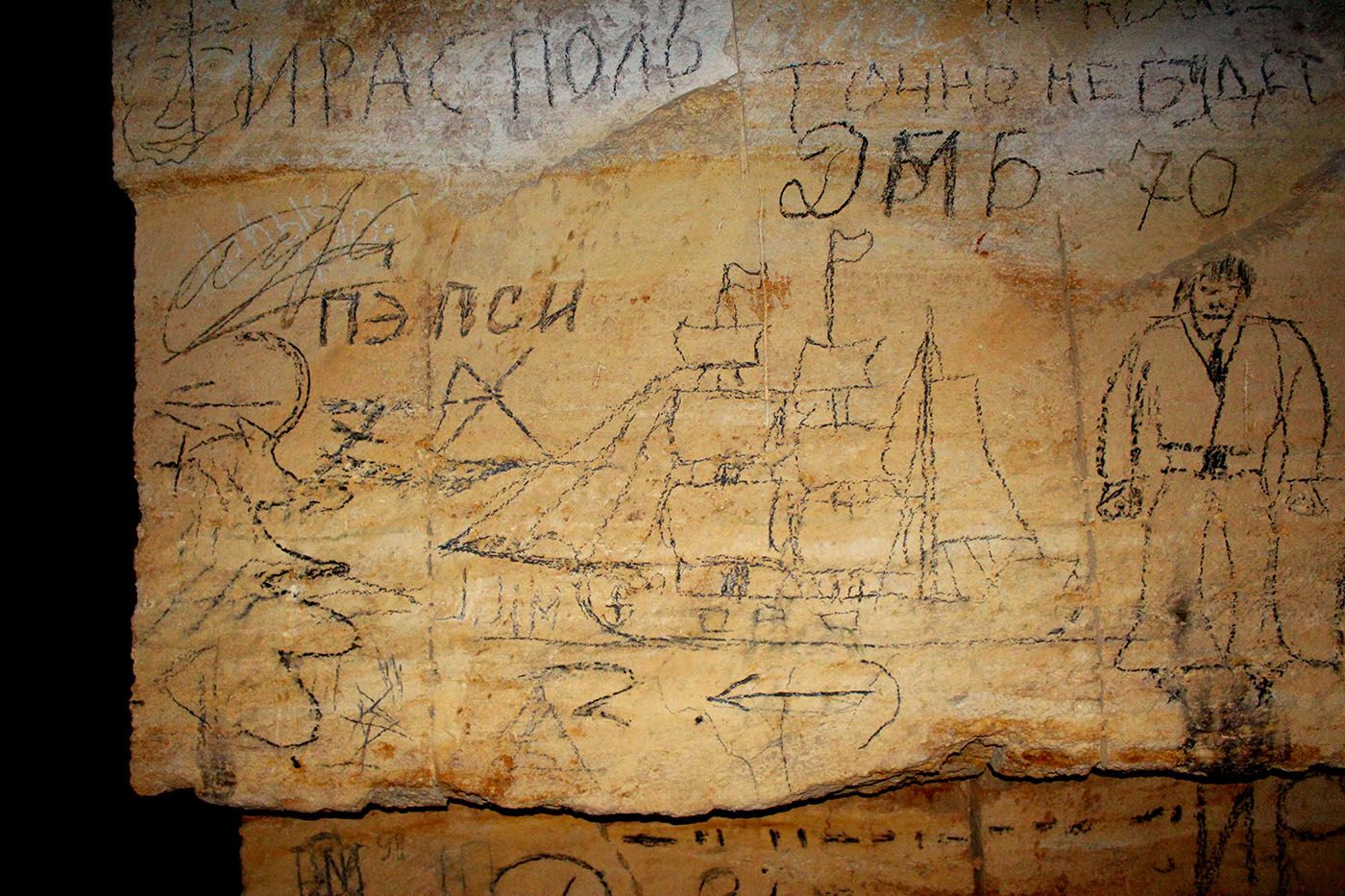
Perhaps the best known myth tells of a wealthy aristocrat, rescued from the sinking Titanic. He was picked up from the wreckage by a brigantine vessel, eventually ending up in Odessa. To honour his rescuers, the man had a ship forged from solid gold. Some say it was a model of the brigantine that saved him, others say the Titanic itself. Either way, the Bolsheviks took control of Ukraine just six years after the Titanic sank – and fearful of having his precious golden ship confiscated by the communists, the man hid his treasure deep inside the catacombs.
Despite the countless expeditions which have been launched to find the golden ship, many claim it’s still down there somewhere: lost in the deep tunnels.
Other tales tell of a spirit – or even a god – that watches over the catacombs. Sometimes known as ‘Bout,’ this vengeful deity protects the treasures hidden therein. It is said that if anyone were to try stealing the precious things away from the Odessa catacombs, that Bout will imprison them in the cold darkness.

Coming around another corner, we entered a large, vaulted chamber – supported by a pillar of bricks at its centre. Vanya was leading the way, heading in the direction of our intended exit. In the next chamber the ceiling had collapsed, layers of brittle limestone forming a mound in the centre. We climbed carefully over the debris. In the tunnel beyond, the ceiling was marked by a deep crack running above the centre of the passage, the two sides rubbing together as they were pressed down by the weight of rock above. It looked about ready to collapse any moment. Vanya told me to duck low, and be careful not to knock it.
Soon enough we reached the exit: the stone tunnel gave way to an earthen burrow, where chiselled steps led up towards the night sky above. I confess to feeling a rush of elation, as I breathed the cold air: I wasn’t going to die down here after all.
My guides warned me that the exit opened onto private property – that we’d have to go carefully, to avoid getting in trouble. Switching off my torch, I led the way out of the tunnel. It opened onto what appeared to be a farmyard, beyond which I could see a gate onto a public road. The problem was, between us and the gate a dark figure stood burning something on a fire. As my eyes adjusted to the dark, I also spotted a guard dog, chained up not far from the tunnel mouth. I reported back – and, returning to the catacombs, my guides decided to look for a different exit.
Back in the tunnels beneath, we followed a series of winding passages that seemed to lead us back towards the depths. I had been invigorated by my brief taste of freedom though, and just the sight of the night sky had given me a new lease of energy.
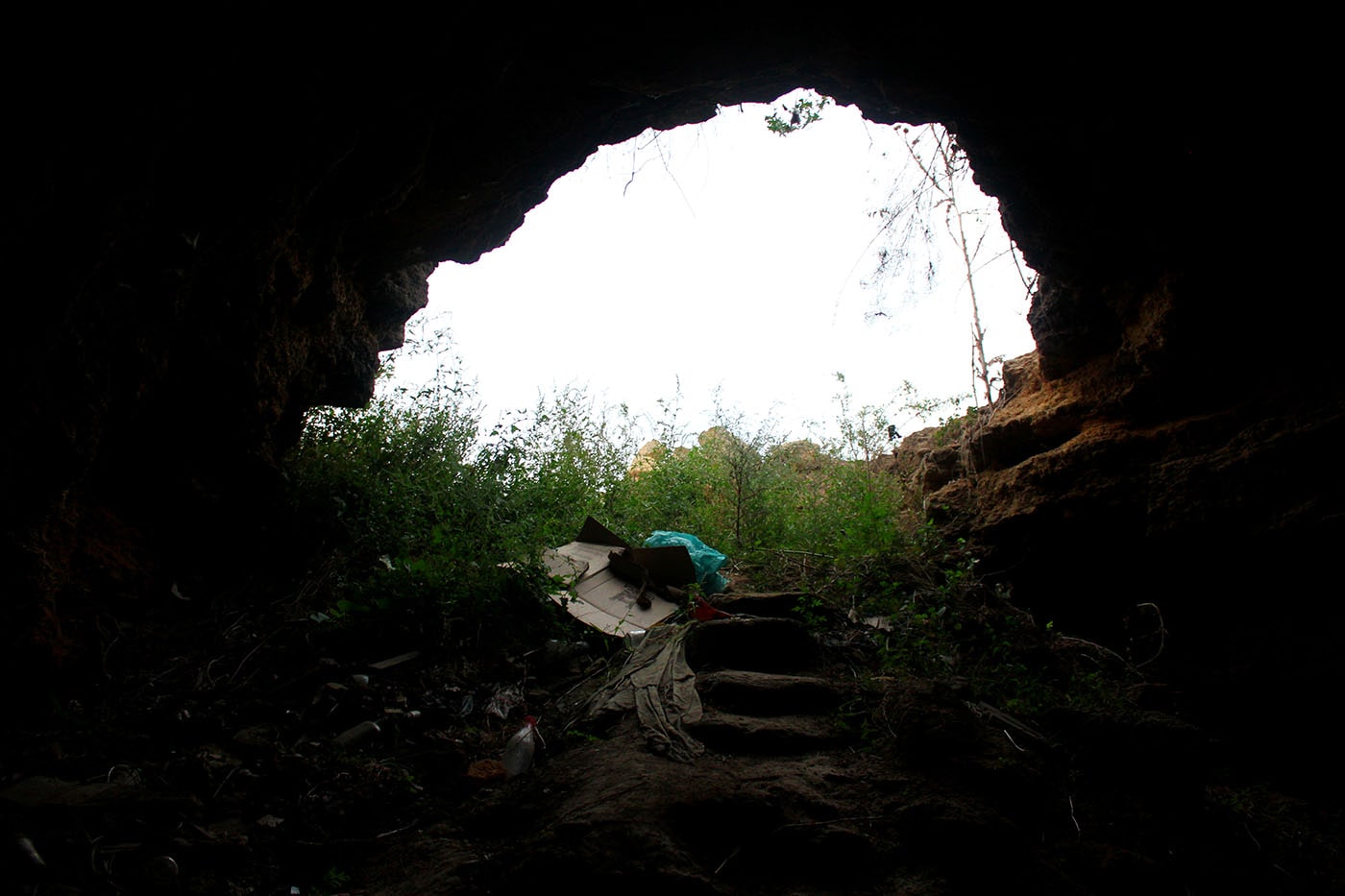
En route to our next exit, we passed by rocks inscribed with lines of handwritten Cyrillic script.

It was Russian poetry, Egor told me, much of it believed to be the work of 19th century miners. One of the faded verses offered praise to the Tsar; another spoke of lost love.
One stanza, initialled ‘OG TS,’ went something like this:
“No treasure, no happiness, you will not find here,
Though forehead knock the wall behind the wall.
Go to the left, go to the right,
You’ll only meet the darkness of the night…”
As we neared the next opening to the surface, we passed a crude shrine – a cross raised to a lost spirit of the catacombs, known as the ‘White Hunter.’ According to my guides, this was the ghost of a hunter who perished in these passages many years ago… and still stalks the tunnel to this day.
And then, finally, we made it to our destination. Much like the last exit, here the limestone passage opened onto a wide crater in the earth. Moving quietly up the steps we crossed the rim, and out into an open field – from where we soon made it back to the main road.
I was exhausted – we had been in the catacombs for around seven hours by this point, most of that time spent walking, crawling or climbing over difficult terrain.
While we’d seen around ten times as much as is included in the official tour (and authentic, unmanicured tunnels at that), it was still a tiny fraction of the network… perhaps 0.5% of the catacombs at most. But I had seen enough; enough to know how little anyone could ever know of these seemingly endless tunnels: the nebulous, uncharted depths of the Odessa Catacombs.


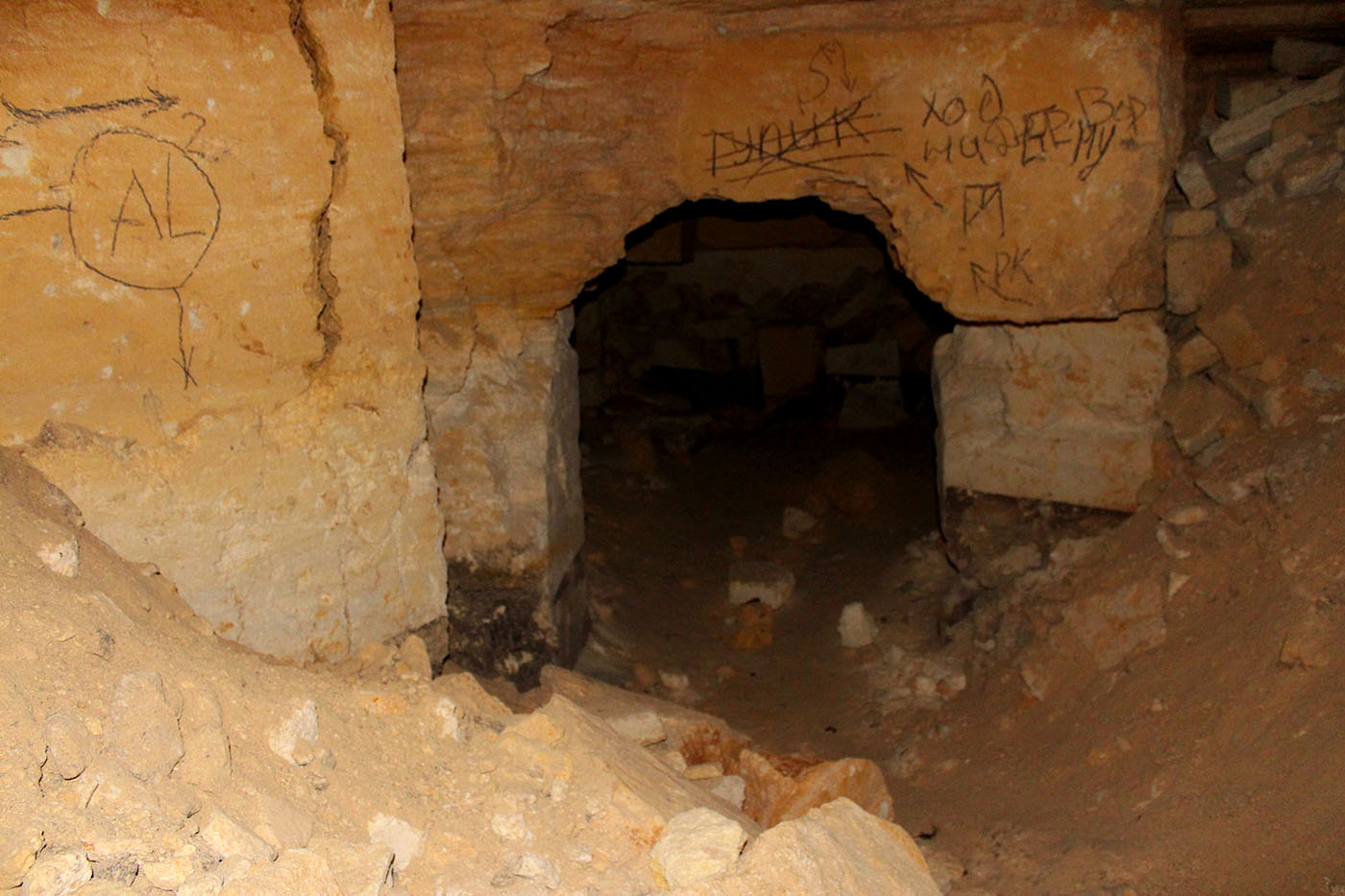
[1] That’s not to say that maps don’t exist, created by various explorers over the years. There are different schools of thought amongst those who explore the Odessa Catacombs, and plenty of enthusiasts have attempted to map these tunnels – such as the ‘Poisk’ club, founded in 1961. For more information, there’s a great article about mapping the Odessa Catacombs over at Atlas Obscura.
![[1] That's not to say that maps don't exist, created by various explorers over the years. There are different schools of thought amongst those who explore the Odessa Catacombs, and plenty of enthusiasts have attempted to map these tunnels – such as the 'Poisk' club, founded in 1961. For more information, there's a great article about mapping the Odessa Catacombs over at Atlas Obscura.](https://www.exutopia.com/wp-content/uploads/2023/07/Ukraine-Odessa-Catacombs-8.jpg)




An illustrated guide to urban exploration in the Russian capital.

Poltergeists, ritual murder & a live-in succubus – the 1000-year-old pub with a ghostly reputation

A month-long monument hunt, and what I learned along the way.
Jesus “All shall seek shelter under rocks or in caves.” From Lot’s Fire/Lightning, 100 LB Talent sized hail.
We are not God’s. We are not causing climate change. The Precession of the equinoxes, eclipsing the nucleus of the galaxies magnetosphere every 12,000 years at the vernal autumnal equinoxes for a 1,ooo years is.
These are just he birhting pains as Jesus put it. Mother Earth’s WATER won’t break with Noah’s floods being pulled around the planet east to west by the MOON until the conjunction of Galactic nucleus-Mercury-Venus-Full MOON-Earth in 2033.
Derenkuyu, Capadoccia, Barbara, Longyou underground cities caves.
Jesus spoke the TRUTH, lived our LIFE & showed us the WAY to survive & thrive in these the climate change END TIMES.
Success is to simplify complex problems and then do it.
Hi, I’ve been thinking about visiting the Catacombs when I visit Odessa at the end of the month. I’ve come across your blog – do you have the name of the company that you went on a tour with? I would like to get of the well beaten tourist path that most others provide and you seem to have a chance to see the tunnels and history properly.
thanks in advance and good work on the blog – quality posts!
I throughly enjoyed reading about the tour that you tok, if I were much younger, I would love to take this journey.
the oldest person visited our tour was 80 years old person, it was not easy for him, but still possible. Activity we do at the tour depends on our guests.
Looking forward to more magnificent urban exploration posts and pics! Was a hobby of mine.
Amazing, thanks for sharing.
You’re welcome!
Interesting read! I would’ve been consumed by my paranoia if that was me.
Thanks – I did have a few moments of doubt myself…
Simply incredible story and photos
Thanks, Shay!
Hey, I’ll be in Odessa this month and you really inspired me to see the undergrounds! Would you mind giving me a contact to your guides?
here it is: http://move.in.ua/en/odessa/what-to-do/29-odessa-catacombs-is-underground-city.html
Hey I have the same idea of seeing the catacombs. I would be interested in your guides info also if you don’t mind. Thank you in advance!
Sure! I’ll send it now.
This sounds amazing! Would you give me the contact information of Egor? As well as any other points of interest you had in the Ukraine. I will be visiting in the beginning of July and would love to do a trip like this.
Thanks!
Hi Alex, yes – I’m happy to pass on the contact details. I’ll send you an email now.
Great article, love the history you’ve included! Any chance you could provide details of your guide I’m planning a trip to Odessa next week with the aim of exploring the catacombs. Thanks!
Thanks Luke! I’ll send you an email now…
Hi, I’ll be in Odessa soon. Are your guides open to more business?
Hi Alex. I haven’t spoken to him for a while, but I’m happy to put you in touch. I’ll send you an email.
I’d also be really keen to do something like this. Could you send me an email as well?
Done!
Hi, I’m in Odessa today and tomorrow. I was wondering if I could get the contact details for your guide?
Hi Rick, I’ll send you an email.
Hey, I’m a french (Paris) catalover. Do you have some relationship to share for enjoying a subtrip in Odessa? Thx for your blog, it’s amazing!
Absolutely! I’ll send you a message.
Fascinating article 🙂 thanks for sharing
Thanks Jessica, glad it was interesting!
I have actually been in the “Museum of Partisan Glory” and have taken the catacomb tour twice. Very interesting place.
Is that the official tour you’re speaking of? Interesting to hear that you enjoyed it… as I had only heard bad things about the tour. Perhaps I’ll have to give it a chance then, next time I’m in Ukraine! Thanks for sharing that.
Amazing
Pretty incredible place, right?
Love!!!!! Stumbled into your journey here as I was researching Ukrainian news.
I look forward to reading about your other adventures. You travel as I dream I could!!!!
Thanks so much! Really glad you enjoyed this – and the blog in general.
My Ukrainian articles certainly seem to be generating more interest than usual at the moment, given current events.
amazing place, never heard about that. Know some large mines in luxembourg, but these are much larger, wow. really interessting.
I still struggle to understand how big this place is… to be able to spend a whole day walking underground, and still see such a small fraction.
Never heard about mines in Luxembourg before though – I’m adding that to my list!
Totally awesome, featuring it in my blog! And added your blog as one of the “Blogs I like”, check “Blog Reviews” tab.
Thanks a lot – both for the kind words, and the generous feature. 🙂
Not a man for package holiday deals, are you? Excellent stuff.
Well, I do try to keep things interesting. Glad you liked this one!
Sounds a fascinating place, although not for the nervous or the foolish.
Kinda sad how people literally treat it like a sewer though.
Yeah, I found that really quite sad… still, it’s their life, their country, and it only detracts from a few small corners of this otherwise vast and magnificent place.